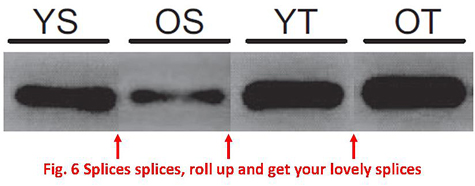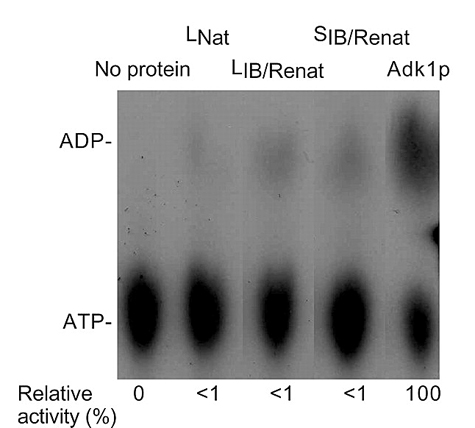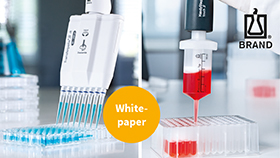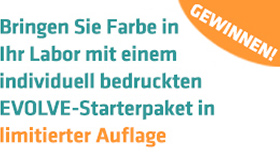Immer wieder stolpern aufmerksame Leser in aktuellen Veröffentlichungen über Abbildungen wie diese:

(aus Figure 6, Diabetes 2008(57): 2933-42; veröffentlicht und mit rotem Kommentar versehen im Blog Science Fraud.)
Was daran „stinkt“, ist klar: Die Blot-Spuren und -Banden stammen ganz offensichtlich nicht aus demselben Experiment und wurden nachträglich im Computer zu einem Bild zusammengeschustert. Das jedoch erlauben die Journals aus gutem Grund nur in Ausnahmefällen sowie unter ganz bestimmten Vorgaben.
Anderes Beispiel:

Und es kostet kaum Mühe, noch weitere Beispiele für solche „Flickschustereien“ aufzutreiben. Der beunruhigende Eindruck, der sich daher aufdrängt: Den allermeisten Autoren scheint gar nicht klar, dass sie mit solchen Manövern mitten in die Grauzone zwischen schlampiger Bequemlichkeit und ernsthaftem Fehlverhalten rutschen.
Nature zum Beispiel beschreibt in seinen „Policies“ zum Thema „Image Integrity and Standards“ ganz klar die Bedingungen, unter denen solche Einzelteile überhaupt nur zu einem Bild zusammengesetzt werden dürfen:
The display of cropped gels and blots in the main paper is encouraged if it improves the clarity and conciseness of the presentation. In such cases, the cropping must be mentioned in the figure legend and the supplementary information should include full-length gels and blots wherever possible. These uncropped images should be labeled as in the main text and placed in a single supplementary figure. The manuscript’s figure legends should state that “full-length blots/gels are presented in Supplementary Figure X.“
Quantitative comparisons between samples on different gels/blots are discouraged; if this is unavoidable, the figure legend must state that the samples derive from the same experiment and that gels/blots were processed in parallel. Vertically sliced images that juxtapose lanes that were non-adjacent in the gel must have a clear separation or a black line delineating the boundary between the gels. Loading controls must be run on the same blot.
Entsprechende Hinweise sucht man in den Abbildungslegenden der beiden obigen Beispiele vergeblich. Geschweige denn, dass sie die kompletten Blots im Supplement enthielten.
Für die Autoren wird durch solche Unterlassungen die erwähnte „Grauzone“ doch ziemlich schnell sehr dunkel. Nicht zuletzt deshalb würde man sich wünschen, dass noch viel mehr Editoren dem Beispiel von Ushma Neill, Executive Editor beim Journal of Clinical Investigation (JCI) folgen würden. Im Jahr 2009 beschloss JCI nämlich, vier bereits akzeptierte und eingeplante Artikel kurzerhand nicht zu drucken, da nach einem letzten Screen herauskam, dass sie exakt die obigen Regeln nicht eingehalten hatten. In dem entsprechenden lesenswerten (!) Editorial „All data are not created equal“ schreibt Neill:
Shall we start with some basic biochemistry? For the examples in this editorial, let’s discuss Western blots in particular (though the rules apply to Northern, Southern, and PCR blots too). We’ve stated before (1) that bands can be spliced together, but only, and I repeat only, if they were noncontiguous but run on the same gel at the same time. The figure then needs a thin line in between the spliced lanes and appropriate text added to the figure legend to reflect the modification.
Und dann geht er in die Details der absoluten „Do’s and Don’ts“ beim Western Blot — um unter anderem nochmals festzustellen:
We allow band splicing — with all the appropriate caveats, as described above. But splicing lanes from various exposures of the same blot doesn’t prove anything. If you expose most any gel long enough, you’ll get bands to appear and the results you want.
So will Neill sein Editorial am Ende als ernsthafte Warnung an all die Forscher da draußen verstanden wissen:
We have tools to be able to detect whether you have altered your figures in any way. If you cut it, crop it, squeeze it, tease it, or otherwise massage it — we can see it. And you can be sure that we have closely examined all figures in the 19 other articles in this issue. I hope that the experiments themselves in our published papers have been performed properly, but that is not something we can police.
Chapeau! Und wie gesagt — ein Beispiel, dem viele folgen sollten. Einige haben es tatsächlich bereits getan.
Schlagworte: Abbildung, Banden, Editor, Fehlverhalten, Journals, Paper, Publikationsethik, Review, Western Blots






I believe that the corresponding author of Diabetes, November 2008 vol. 57 no. 11 2933-2942
http://diabetes.diabetesjournals.org/content/57/11/2933.long
K. Sreekumaran Nair, nair.sree@mayo.edu
is the present editor-in-chief of Diabetes.
http://diabetes.diabetesjournals.org/site/misc/edboard.xhtml
Am I missing something?
Mal ein positives Beispiel: Nature Cell Biology zwingt die Autoren die vollständigen Gele/Membranen im Supplement zu zeigen. Das sollte Schule bei allen Journals machen, insbesondere den biochemisch orientierten, bei denen oft in den Blots die Hauptaussage des papers steckt
Genau das steht ja auch in den oben zitierten „Policies“ von Nature:
Dear David-
At the time this paper was published, the policies on presenting representative blots were just beginning to emerge. Indeed, a clear line between the juxtaposed lanes should have been added for clarity. A corrigendum was published to address this issue.